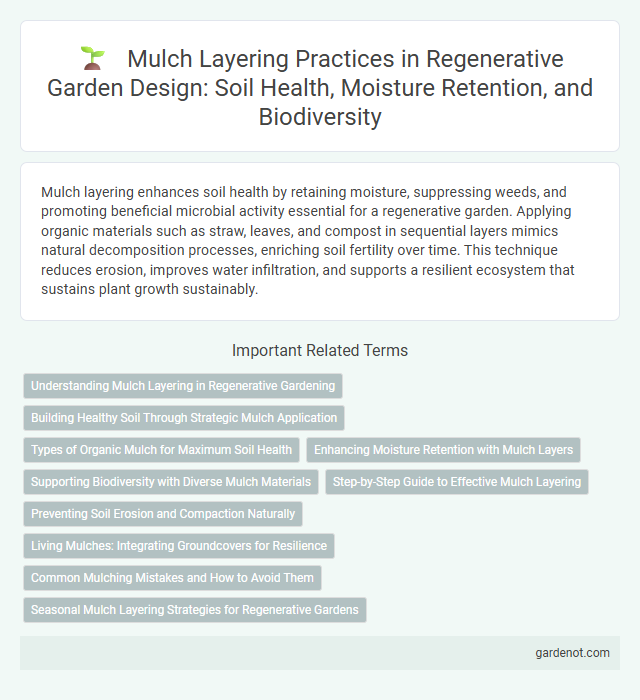Mulch layering enhances soil health by retaining moisture, suppressing weeds, and promoting beneficial microbial activity essential for a regenerative garden. Applying organic materials such as straw, leaves, and compost in sequential layers mimics natural decomposition processes, enriching soil fertility over time. This technique reduces erosion, improves water infiltration, and supports a resilient ecosystem that sustains plant growth sustainably.
Understanding Mulch Layering in Regenerative Gardening
Mulch layering in regenerative gardening enhances soil health by creating a protective cover that conserves moisture, suppresses weeds, and promotes beneficial microbial activity. Effective mulch layering involves using diverse organic materials like leaves, straw, and compost to mimic natural forest floor conditions, fostering nutrient cycling and improving soil structure. Proper thickness, typically 2-4 inches, balances moisture retention and aeration, supporting robust plant growth and long-term ecosystem regeneration.
Building Healthy Soil Through Strategic Mulch Application
Strategic mulch layering enhances soil health by regulating moisture, suppressing weeds, and fostering beneficial microbial activity, critical in regenerative gardening. Organic mulches like wood chips, straw, and compost decompose slowly, enriching the soil with vital nutrients and improving its structure over time. Proper application of mulch layers maintains optimal soil temperature and reduces erosion, promoting resilient plant growth and sustainable ecosystem balance.
Types of Organic Mulch for Maximum Soil Health
Organic mulch types such as shredded bark, straw, compost, and leaf mold provide essential nutrients and improve soil structure in regenerative gardens. These materials enhance moisture retention, suppress weeds, and foster beneficial microbial activity crucial for soil health. Selecting the right mulch based on garden needs maximizes nutrient cycling and promotes sustainable plant growth.
Enhancing Moisture Retention with Mulch Layers
Mulch layering significantly enhances moisture retention by creating a protective barrier that reduces evaporation from the soil surface. Organic mulch materials like straw, wood chips, or shredded leaves absorb and slowly release water, maintaining consistent soil moisture levels essential for plant health. This technique minimizes water stress, supports beneficial soil microbes, and encourages deeper root growth in regenerative gardening systems.
Supporting Biodiversity with Diverse Mulch Materials
Using diverse mulch materials like shredded leaves, wood chips, straw, and compost supports biodiversity by providing varied habitats for beneficial insects, fungi, and microorganisms. Different organic mulches enhance soil health through nutrient cycling and moisture retention, promoting a resilient garden ecosystem. Layering mulch strategically protects plant roots while fostering a rich web of soil life essential for regenerative growth.
Step-by-Step Guide to Effective Mulch Layering
Start by clearing the soil surface of weeds and debris to prepare a clean foundation for mulch application. Apply organic mulch in layers of 2 to 4 inches, ensuring each layer is evenly distributed to retain moisture and suppress weed growth effectively. Maintain a mulch-free zone of a few inches around plant stems to prevent rot and encourage healthy root development.
Preventing Soil Erosion and Compaction Naturally
Mulch layering protects soil by reducing surface runoff and minimizing erosion, preserving nutrient-rich topsoil essential for plant health. It absorbs rainfall impact, preventing soil compaction and maintaining aeration critical for root development and microbial activity. Organic mulch decomposes gradually, enhancing soil structure and water retention, fostering a resilient and regenerative garden ecosystem.
Living Mulches: Integrating Groundcovers for Resilience
Living mulches, such as clover or vetch, enhance soil structure and nutrient cycling by maintaining continuous root coverage in regenerative gardens. These groundcovers suppress weeds, reduce erosion, and increase biodiversity, promoting ecosystem resilience and long-term soil health. Integrating diverse living mulches improves moisture retention and supports beneficial microbial communities critical for plant growth.
Common Mulching Mistakes and How to Avoid Them
Common mulching mistakes in regenerative gardens include applying mulch too thickly, which can suffocate soil and cause water retention issues, and placing mulch directly against plant stems, leading to rot and pest problems. To avoid these issues, maintain a mulch layer of 2-3 inches and keep it a few inches away from the plant bases to ensure adequate air circulation and moisture balance. Regularly monitoring mulch depth and condition promotes healthy soil microbial activity essential for regeneration.
Seasonal Mulch Layering Strategies for Regenerative Gardens
Seasonal mulch layering enhances soil health and moisture retention in regenerative gardens by adapting organic materials to weather conditions; in spring, nutrient-rich compost and leaf mulch boost microbial activity, while summer benefits from straw or grass clippings to reduce evaporation and suppress weeds. Autumn mulch layers incorporate shredded leaves and wood chips that insulate plant roots and gradually decompose, enriching soil organic matter through winter. Winter mulch strategies use protective layers like straw or evergreen boughs to prevent frost damage and maintain soil structure for early spring growth.
Mulch layering Infographic

 gardenot.com
gardenot.com